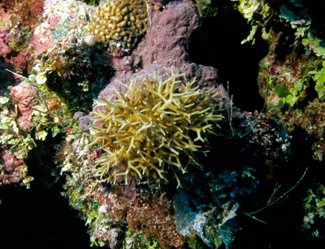Deep-water corals adapt to low light

GETTING SOME SUN ISN’T easy when you live 30m under the ocean surface, but some coral species seem to manage surprisingly well.
In the twilight realms of the Great Barrier Reef, the spiky bird’s nest coral (Seriatopora hystrix) has developed ways to thrive in low-light conditions, Queensland researchers say.
Corals are usually found in shallow water where there is adequate light for them to use for photosynthesis. In the mesophotic region, 30-150m below the surface, much less light is able to penetrate and until recently, scientists have wondered how some deep-water corals survive in such conditions.
“Particularly below depths of fifty metres, it gets pretty dark down there,” says Pim Bongaerts, marine biologist at the University of Queensland and author of the study. “The light that is still present is of a very deep blue colour. The coral looks therefore pretty dull when you’re down there, but if you shine a light on them you see they’re in fact very bright and colourful.”
The intense colour “helps them capture the little bit of light that is present at these depths for photosynthesis,” Pim told Australian Geographic.
Deep corals better at using nutrients
Reef-building corals are colonial animals that live in symbiosis with algae, which provides energy from photosynthesis and receives protection and nutrients in return.
The population of bird’s nest corals and their symbiotic algae living 30m under the ocean, however, are genetically distinct from their shallow-water counterparts, the researchers found.
These deep corals grow faster and occur in greater numbers than shallow corals, Pim says. They seem to be able to do this because they are better able to exploit nutrients and plankton, and have a higher density of algae in their tissue, he says.
RELATED GALLERY: new discoveries deep in the Coral Sea
Coral the rainforests of the ocean
To see if coral could flexibly adjust to depths, scientists transplanted small samples at Yonge Reef, on the edge of the continental shelf in the far northern Great Barrier Reef. They found shallow-water corals couldn’t grow well at depths of around 30m, just as deep corals fared poorly in shallow water.
The offspring of these corals are unlikely to migrate naturally either, as they maintain their specialisation for deep water. As a result, they don’t seem to interbreed with corals of other depths.
Coral reefs are sometimes known as ‘rainforests of the ocean’ for their diversity. Pim says his study shows how corals have had to evolve and diversify to adapt to a new ecological niche.
Tom Bridge, who studies deep-reef corals at James Cook University and led a deep coral expedition partly funded by the Australian Geographic Society, says the research is very interesting. “A lot of people tend to think coral reefs are coral reefs, but what this shows is different environments can cause coral to be very different physically and genetically.”
The research was published last week in BMC Evolutionary Biology.
RELATED STORIES

